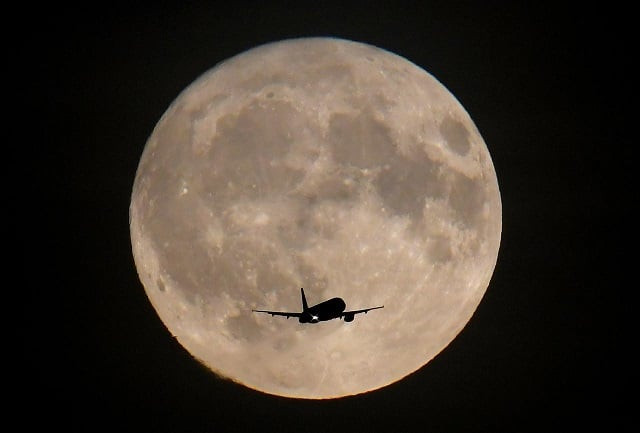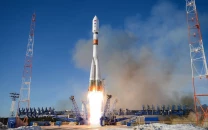NASA plans to send water-hunting robot to moon surface in 2022
NASA will send a golf cart-sized robot to the moon in 2022

A passenger plane is seen with the full moon behind as it begins its final landing approach to Heathrow Airport in London, Britain, September 24, 2018.PHOTO: REUTERS
The VIPER robot will drive for miles on the dusty lunar surface to get a closer look at what NASA administrator Jim Bridenstine has touted for months: underground pockets of “hundreds of millions of tons of water ice” that could help turn the moon into a jumping-off point to Mars.
NASA aims for first manned SpaceX mission in first-quarter 2020
“VIPER is going to assess where the water ice is. We’re going to be able to characterise the water ice, and ultimately drill,” Bridenstine said on Friday at the International Astronautical Congress in Washington.
“Why is this important? Because water ice represents something significant. Life support.”
VIPER stands for Volatiles Investigating Polar Exploration Rover.
The rover is expected to arrive on the moon’s south polar region in December 2022, carrying four instruments to sample lunar soil for traces of hydrogen and oxygen - the basic components of water that can be separated and synthesized into fuel for a planned fleet of commercial lunar launch vehicles.
First all-female spacewalk now later this week, says NASA
In development at NASA’s Ames Research Center in California, the VIPER robot will log “about 100 days of data that will be used to inform the first global water resource maps of the moon,” NASA said in announcing the plans.
NASA is in the process of kickstarting its Artemis program, an accelerated mission to put people back on the moon for the first time since the 1970s to train and prove technologies that would later be sent on a Mars mission. Scientists have eyed lunar water as a key resource for enabling long-duration astronaut missions on the moon, though its form and exact amount are unknown. VIPER will aim to find out.
NASA crashed a rocket onto the moon’s south pole in 2009 to confirm traces of lunar water ice in the plume of dust kicked up upon impact.



















COMMENTS
Comments are moderated and generally will be posted if they are on-topic and not abusive.
For more information, please see our Comments FAQ